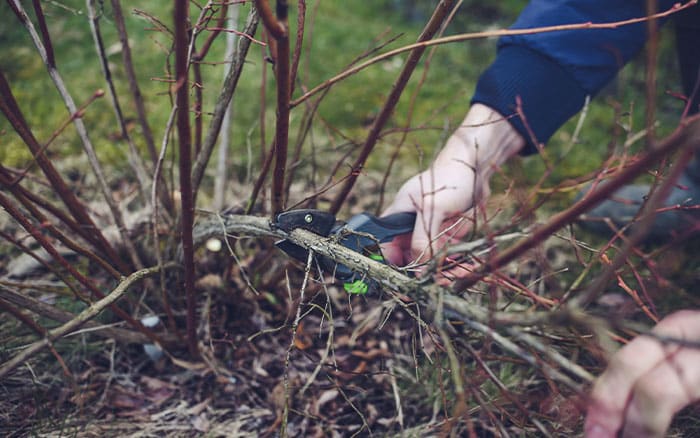If you’re growing soft fruit bushes such as currants and gooseberries, pruning and training them regularly keeps them looking good. Also, this will help them to keep producing lots of delicious berries.
The good news is that this is best done during the winter months. This is when the plants are dormant. Plus, this is a time of year when there’s not much else to do in the fruit and veg plot. Therefore, meaning you’ve plenty of time to get the job done!
What shape to prune fruit bushes
The ideal shape for fruit bushes is an open-centre one.
Aim to have a maximum of ten main branches on each bush. Maintain plenty of space between them as the main structure of each fruit bush. Each of those main branches should have lots of thinner, shorter shoots growing out of the sides of each branch.

Why create an open shape for fruit bushes?
Creating an open shape does several things. Firstly, it allows air to circulate freely around the fruit bushes, which helps to prevent air-borne diseases.
Secondly, it helps fruit to ripen and thirdly makes it easier for you to harvest the fruit!
How to prune established fruit bushes – general principles
The general rule of ruling is always to start by removing any dead, diseased or damaged shoots.

Main branches
Next cut back the previous season’s growth on the main branches by between a quarter and a half. You can tell the difference between older growth and the previous season’s growth by the stem colour and width. The previous season’s growth will be thinner and a lighter shade of brown than the older growth, a darker brown.
Then prune the side shoots, but before doing so, stand back and look at the main branches. If the bush is mature, you may have noticed some branches starting to produce less fruit than others.
To encourage it to produce more fruit you’ll need to remove just a couple of older main branches. Do so either each year or every other year.
Side shoots
These require more drastic pruning.
Trace each side shoot back to where it grows out of the main branch. Then, find the first two buds growing on the side shoot, and prune just above that second bud.
Look out for side-shoots that have the potential to grow as replacements for the less fruitful main branches you’ve removed. Leave these unpruned.

Low-growing branches
Remove any that will touch the ground when laden with fruit to reduce the chances of pest damage.
A few exceptions
Blackcurrants should be pruned harder than redcurrants, removing in total about one-third of the bush.
For redcurrants, whitecurrants and gooseberries, shorten all branches and shoots by about a third.
Blueberries won’t need pruning for at least two years after planting. At which stage, remove a quarter of the old stems, cutting back to the base of the plant.



Grow new plants for free
If you’ve removed one or two of the main branches, consider taking part of the branch as a cutting to grow more fruit bushes. Look for lengths of about 25cm and the width of a pencil for currant bushes. And half as thick as that for gooseberries. Make a straight, horizontal cut at the end of the length and a sloping cut at the top end. This will help you to identify the top from the bottom!
Leave the top three buds growing on the stem and gently rub off the remaining ones.
Loosen the soil where you have anything growing in it next year and push the cutting into it. Push it down until the top two or three buds are above ground. If you have more than one cutting, leave a 20cm space between each. And remember to insert a label by the cuttings!
By spring, the cuttings should be producing new leaves. Keep well-watered and clear of other vegetation growing around the stems until the following autumn. This is when the cuttings can be dug up and either put into containers or planted in their new growing position.

Be bold!
It’s tempting to be timid but remember, lots of thinning creates an open shape for an easy to manage shrub. Also, it tells the plant to produce new, fruit-bearing shoots for the following season!

Leave A Comment